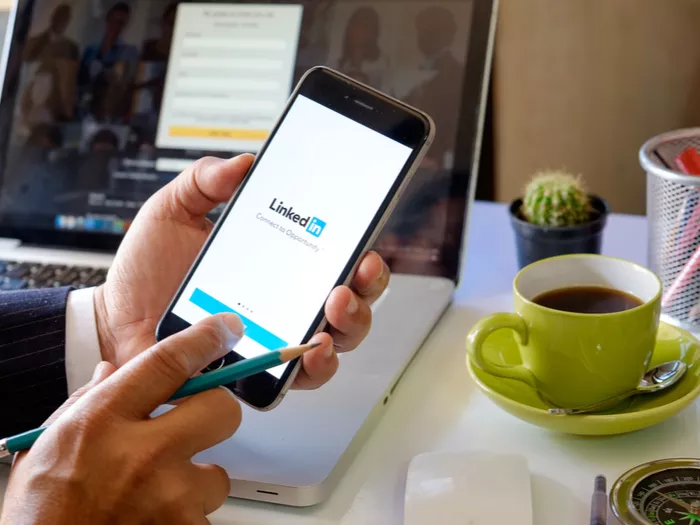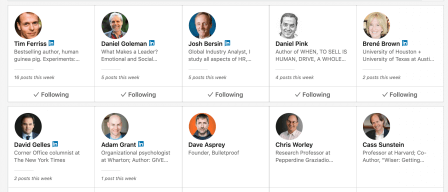There is so much power in LinkedIn when you know how to harness it. Some of my favorite strategies include:
- Spot insights and trends
- Learn and share best practices
- Shop and test your ideas
- Be a brand ambassador
Many people use LinkedIn as nothing more than an online Rolodex, a means of finding a job, or a quick daily glance through professional updates and eye-roll-inducing humblebrags. But when you look for the tips and tricks hidden away in its many nooks and corners, you can do some pretty amazing things on LinkedIn’s virtual platform.
With so much uncertainty persisting today, we’re all looking for ways to go above and beyond just getting our projects done on time. It’s more important than ever to really shine at work. Today we’ll talk about some strategies you can use on LinkedIn—all from the comfort of your likely-virtual office—to stand out.
With LinkedIn, you can:
- Be the bringer of industry trends and insights
- Introduce new practices to your team
- Deliver more creative and fleshed-out ideas
- Be a great ambassador for your company
Let’s dive in!
Spot insights and trends
Raise your hand if your primary engagement with LinkedIn is a periodic check of whatever comes up in your organic feed. (Don’t worry; I can’t see you. Go ahead and raise it.)
This is the default behavior on LinkedIn. It means you’re seeing whatever has been posted by your connections—those in your network. What do you find there? Usually a combination of job updates and shared articles, maybe sprinkled with some promoted content.
Spending five to ten minutes seeing what’s happening in your network can be interesting and relevant. But if you really understand the power of LinkedIn, you can use those same five to ten minutes to spot industry-shifting trends and insights from leading thinkers and institutions—insights you can bring to your team to shift or challenge thinking.
Next time you’re on the platform, pull yourself away from the not-so-riveting feed and focus instead on curating the content you see. Choose people (thinkers and business leaders), institutions, and hashtags you’d like to follow. Here’s a screenshot of a few thinkers I follow.
I may not have access to people like Brene Brown, Dan Pink, or Adam Grant in real life. But LinkedIn is where they share deep, insightful pieces that shape my thinking and perspective, as opposed to snippy tweets or Insta-worthy photos.
You may be completely unsurprised to hear that I follow hashtags like leadership, workplace success, communication, and podcasting, just to name a few. This ensures that heated and popular conversations on these topics will dominate my feed instead of vanilla job updates.
As a business owner, I use this strategy to find insights and articles that I share with clients and sometimes even bake into the sessions I design for them. But it works equally well for an employee of an organization.
Spend a few minutes curating your feed. See if you can’t quickly spot a nugget of golden insight amongst what the influencers have to say. Bring an idea to your team and see what shift you might spark.
Learn and share best practices
Following influencers and hashtags is a great passive strategy. But let’s talk about something a bit more interactive. LinkedIn groups are a fabulous forum for participating in hot topical conversations. You can join groups based on nearly any affinity you can think of—the school you attended, past employers, your industry, your geography, your interests, and more. Groups may be open (anyone can join) or closed (an administrator must approve you) but once you’re in a group, it’s a great place to start and/or participate in a conversation.
Maybe you’re struggling with a situation at work and could use some advice. Or you’re trying to find the best ways to engage with customers in your industry and you’re seeking ideas that other companies have tried and tested. Maybe you have an inkling about something (“Hey, does anyone else think virtual work might be here to stay?”) and you’re curious to see how other people think about the same issue.
Pose a question or challenge to a relevant LinkedIn group to see what others think—make it a real conversation. While you’re there, be sure to look through existing conversations for opportunities to add value. Do you have an opinion or suggestion to offer on someone else’s conundrum? The more generous you are with your thoughts and ideas, the more generosity you’ll see in exchange.
Shop and test your ideas
Thirteen years ago I made a big career change, transitioning from Operations Management into a role in Human Resources for a financial institution. Excited as I was by the switch, I spent my early months feeling out of my league.
I was motivated to impress, but also lacked confidence in my instincts and ideas. While trying to figure out how to get quickly up-to-speed, I found myself searching LinkedIn for people in other companies and industries with titles similar to my own and sending invitations to connect.
As my invitations were accepted, I started following up with a brief note of introduction. Here’s what the note included:
- My statement that I was relatively new in my job role
- A list of a few projects or initiatives I was working on (nothing confidential, of course)
- A request to connect for a quick phone chat to share some best practices
Using this strategy, during my first year on that job, I must have spoken with 30-40 people in roles equivalent to mine at other companies. We didn’t have an agenda. Instead, we chatted casually about things we were working on, strategies we found successful, what hadn’t worked for us, questions we were noodling on, and more.
It was an amazing way for me to grow my network while also growing my knowledge and idea bank. Sometimes I’d have an idea I wanted to try at work, and I’d use these phone sessions to test them with someone else. I’d say “hey I’m thinking of trying this – have you done anything similar? Any wisdom to share?” In many cases, they’d say yes and tell me what they thought or knew.
And over time, as I accumulated experience, I was able to contribute more to these conversations. It ultimately became one of the most powerful strategies I’ve used to bump up my own rockstar status at work.
Use LinkedIn search tools to find people in roles similar to your own. After you connect, send a brief introductory note telling them who you are and what you’re working on. Invite them to a quick, informal phone chat to talk about their work and share some ideas and best practices.
Be a brand ambassador
So far we’ve touched on some strategies designed to bring great things in. Now, let’s talk about how you might help your company stand out. Putting your company on the map by highlighting its achievements is another great way to be noticed or recognized at work.
As you begin to follow the trends and conversations shared by big thinkers in your industry, consider where you can highlight work you or your company are doing that contributes to the conversation.
Has a product been launched or an outcome been achieved (again, nothing confidential) that lends itself to a trending hashtag? Tell that story and be an ambassador for your company’s great work. Be sure to tag your company. Touting what you’re proud to be a part of, and contextualizing it to the current conversation, is a great way to stand out within your organization. Leadership will notice your efforts.
And speaking of LinkedIn and rockstars, have you heard that Modern Mentor now has its own LinkedIn page? You’ll find updates on future episodes, quick how-to videos on some of work’s biggest challenges, and additional content that will only be available on LinkedIn. Stop by and leave me comments or questions—I’ll respond to all of it! You may even end up being featured on the show.





